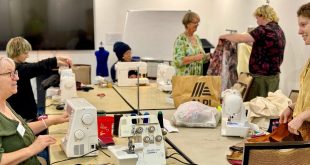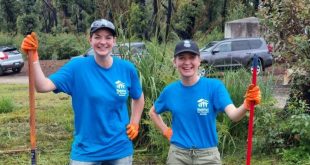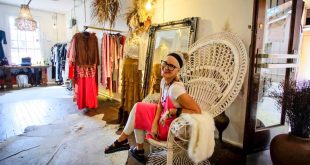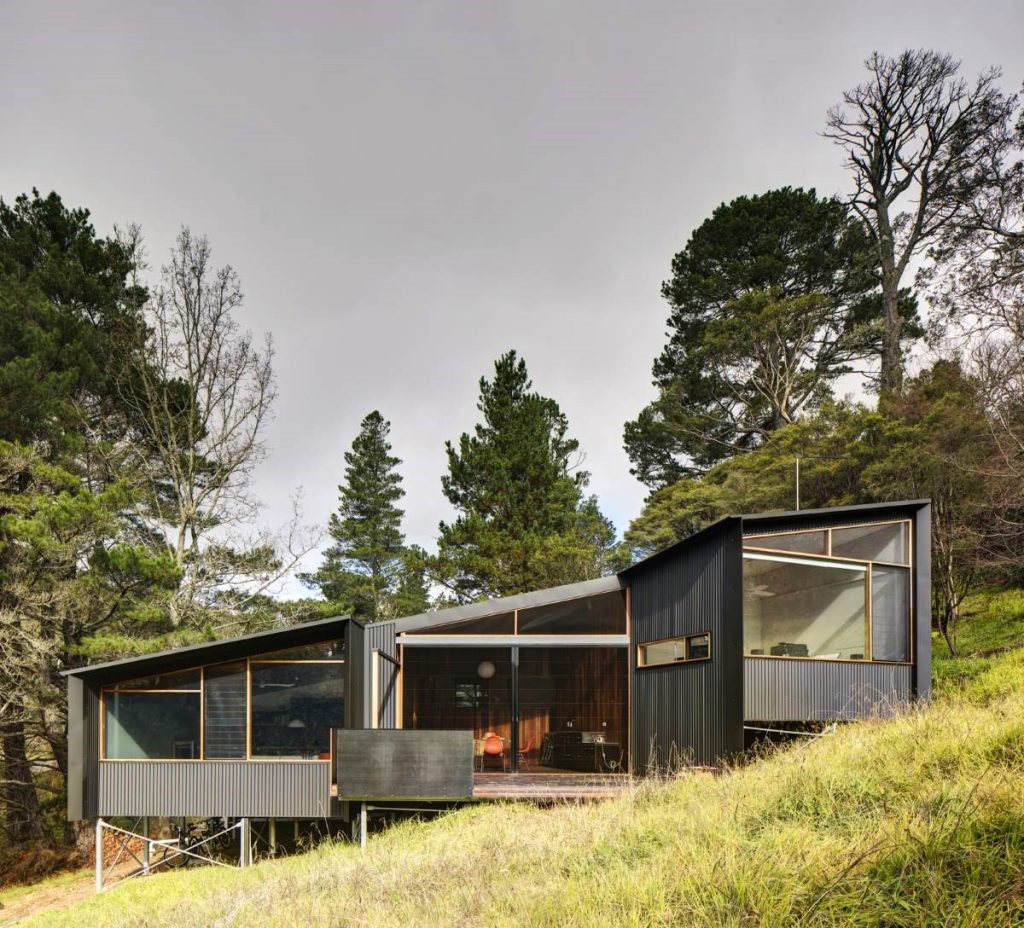
Carol and Ken’s home in Leura takes advantage of, and protects, the natural landscape. (Photo: Brett Boardman)
Story by Linda Moon
Ken and Carol’s home in Leura offers insights into sustainable building design we can all take inspiration from.
Key Points:
- Most Blue Mountains homes aren’t built for the local environment.
- Sustainable housing is more than solar panels and water tanks.
- By understanding and working with nature we can reduce energy costs and help the environment.
Perched on the hillside, a slate-coloured building blends into the landscape. There are no signs of a concrete drive, garage or fencing: those Aussie architectural mainstays. Instead, a mulched path meanders through conifer trees.
This isn’t your average property. Designed by architects Ken Yeh and Carol Marra (the multi-awarded Marra + Yeh), it has a lot to teach us about how to design alongside nature, for the planet and ourselves. It’s a journey so many of us are interested in.
Building with the environment in mind
The duo studied architecture at the University of Texas (where they met).
Ken:
Ken grew up around the tropical jungles of Malaysia and is both tutor and guest critic at the University of Sydney and UNSW. “I have a benchmark in my head of how things should be in a mature and stable eco-system. It’s a feeling. You go into a pristine place; all your senses can tell you. You can hear it; you can feel it.” His goal in designing is to try to discover what a place was originally like, then how to enhance it.
Carol:
Carol, who is originally from Argentina, also has a deep understanding of place. She also tutors and is a guest critic at the University of Sydney and UNSW. Carol says sustainable, ecological design (which the pair specialise in) starts with considering everything outside your piece of land and thinking holistically. “Across the street from us is a creek. We understand what happens here affects the waterway and the animals that drink it. So, it’s big picture thinking,” she says.
It’s also about making buildings that can survive the changing climate conditions, plus respond to the energy crisis.
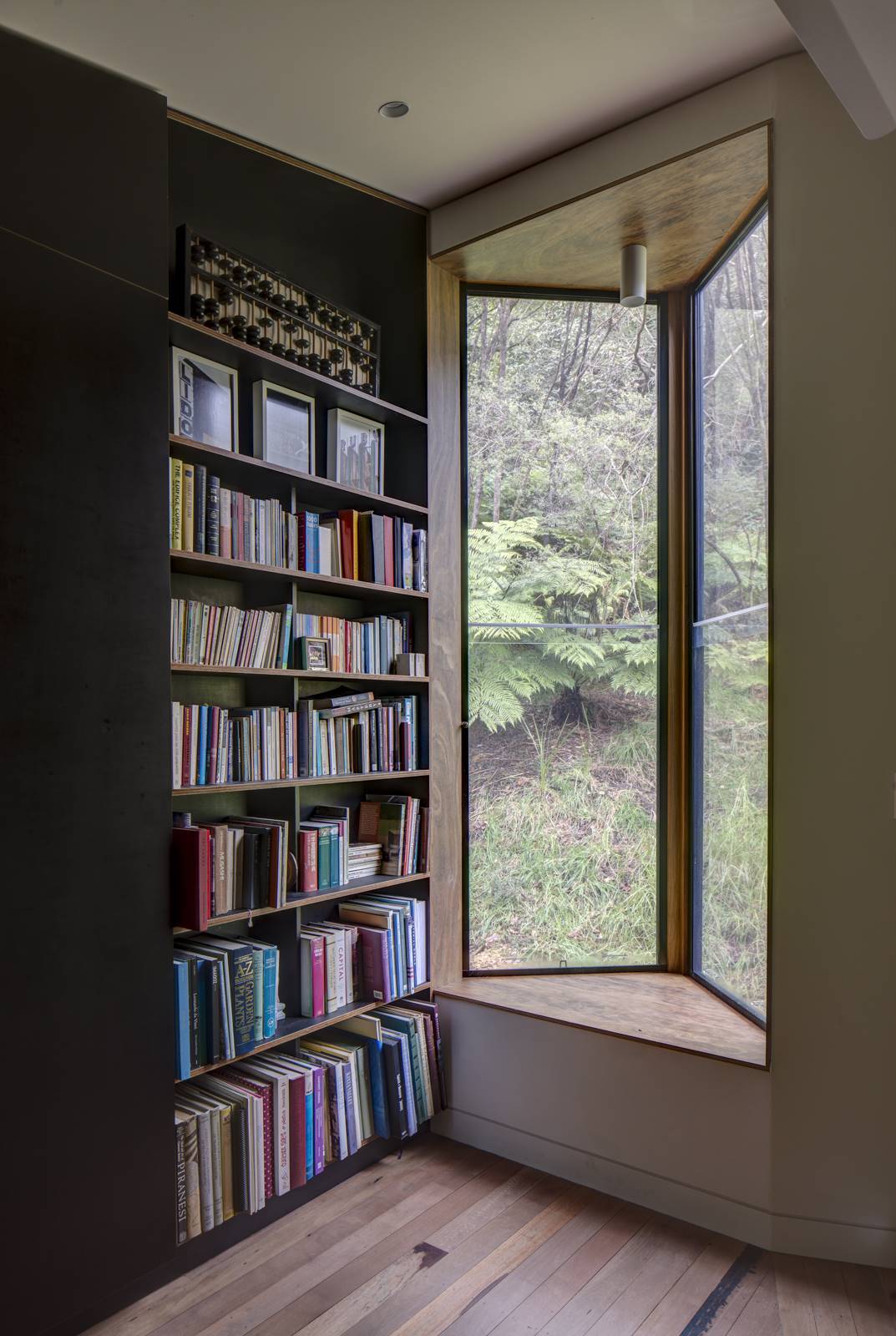
Two windows promote cross ventilation and natural sunlight while storage is a must. (Photo: Brett Boardman)
The house that Ken and Carol built
Elevated above a hanging swamp, the home’s design allows water to seep unimpeded down into the creek.
Caring for the land flows both ways. By not blocking the water’s path they avoid flooding and dampness, Carol says. Another perk: the relaxing sound of running water.
Inside, things are equally interesting. In the ‘mud-room’, as they call their entry, there’s a bench, washing machine, clothing rack and fridge. Here, dirty and wet clothing are discarded and shoes exchanged for slippers. It turns out the freezer is located here to reduce energy use: it’s the coldest zone of the house.

Sustainable architects Ken Yeh and Carol Marra at home. (Photo: Linda Moon)
Beyond solar panels and tanks
“Sustainable design is not just about adding on; it’s not just about buying solar panels,” Carol emphasises.
Our starting point should be to make use of everything nature gives us for free, Ken says. This includes sunshine (warmth), breezes (which cool), soil (for creating gardens) and water.
Every part of the building is planned consciously. Bedrooms are located on the south (least sunny side) of the building. “Sleeping in a cold room is better for you,” Carol says. And, being further from the road, it’s also quieter.
The bathroom is designed for multiple use with separate compartments for hand-basin, toilet and showering. The latter includes an adjustable-size wooden Japanese bathtub (designed by the pair) and an expansive window that looks out onto 3D art courtesy of nature: trees, occasional wallabies and birds.
Bathing with the window open allows airflow to remove humidity and condensation.
“You need to identify the gifts [of nature] and accept them humbly.” – Ken Yeh.
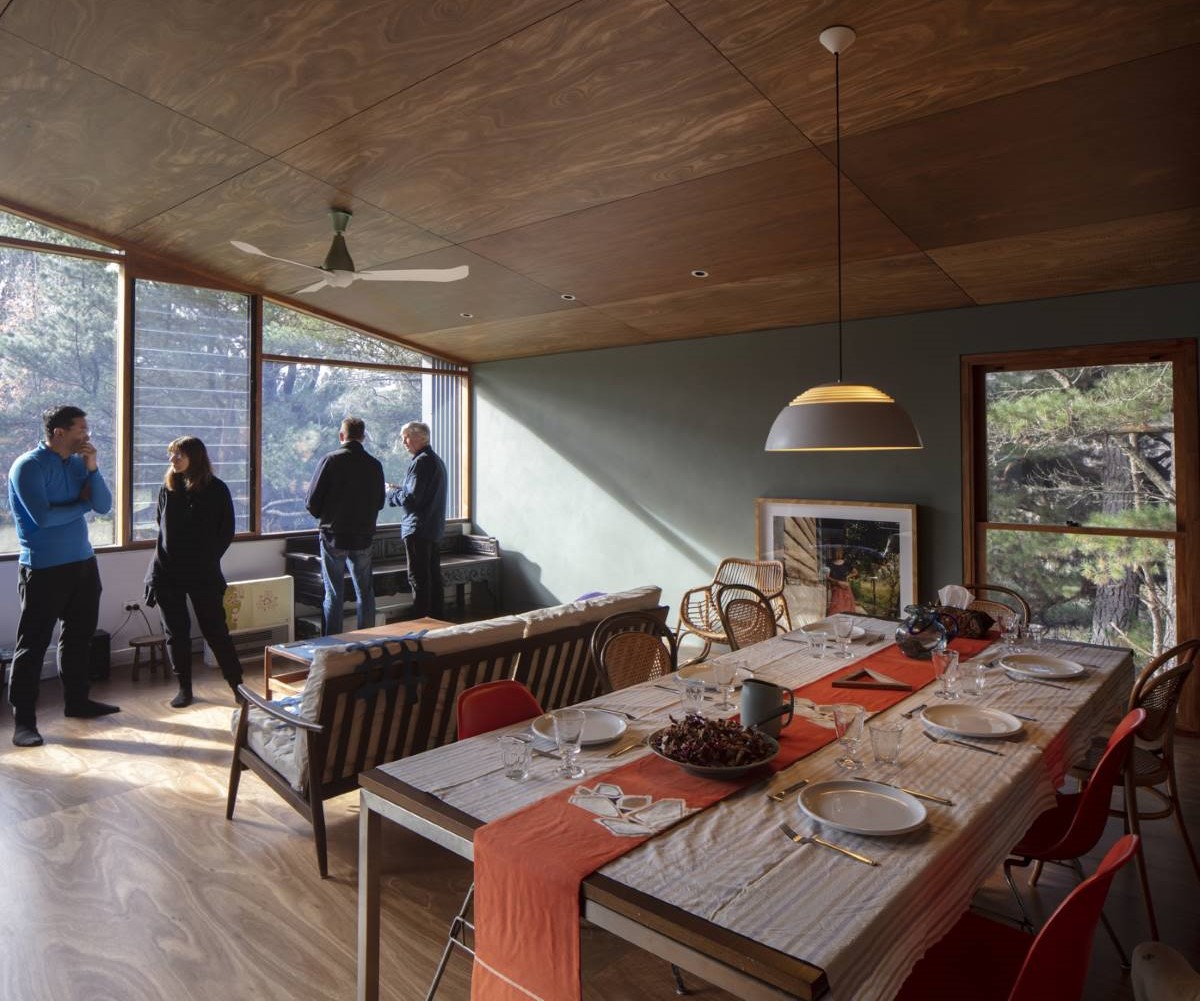
Large north-facing, double-glazed windows harness the sun’s heat and light. (Photo: Brett Boardman)
Passive design
Designing with your local climate in mind is known as ‘passive design’. Some understanding around science, like wind direction and the sun’s angle, helps here, Carol adds.
To capture free heat from the sun, the main living zones are situated in the north. Large, double-glazed, north facing windows allow sunlight to penetrate deep into the rooms. On sunny days these don’t require artificial heating, which equals lower energy costs and CO2 emissions.
When it’s hot they open the windows to the breeze or use blinds to block the sun. “It’s a way of calibrating your building to what’s happening outside,” Ken says.
The rooms are also designed to be compartmentalised to keep the heat in. “In winter you create smaller spaces; in summer bigger spaces,” Carol says. “You live in nature.”
The living area opens up to an outdoor space with a kitchen and insect-proof screens that allow them to take advantage of any cooling breezes on hot summer nights.
In the mountains most winds come from the west. Thus, the house has few windows facing west.
“Look at nature first. The water flows under, the wind flows over.” – Ken Yeh.
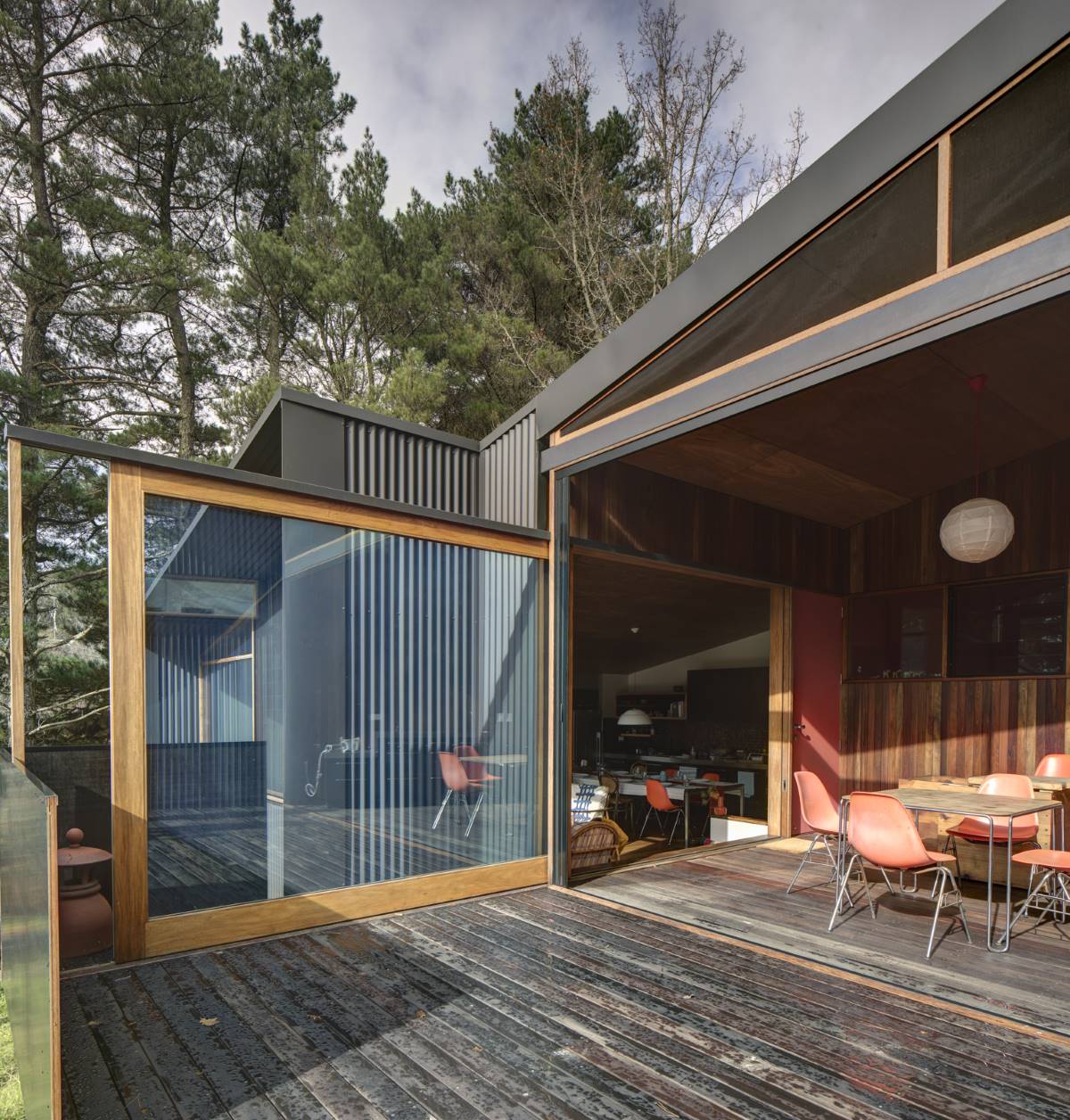
Space for a wok BBQ. The indoors and outdoors blend seamlessly thanks to clever use of glass and almost invisible insect screens. (Photo: Brett Boardman)
Designing for flexibility and change
Other important features of the home include built-in storage cupboards and enormous doors between several rooms. This allows for flexibility. Rooms can be opened up to become bigger or used for a different purpose.
It’s about designing alongside time, Ken says. How we work and study, for instance, has changed; the composition of families changes, Carol says. The ability to enable change without too much pain adds value to a building.
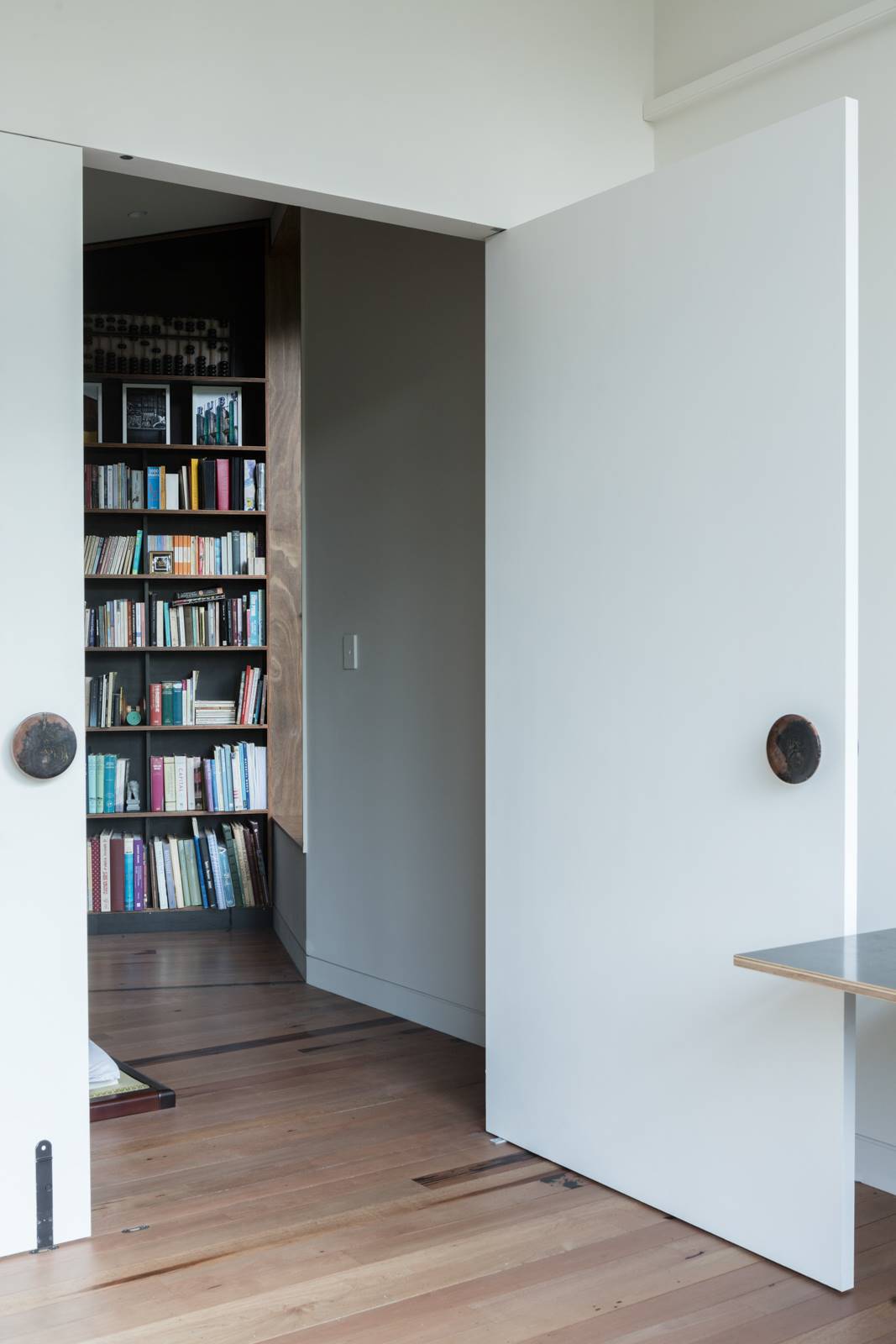
Large doors allow spaces to be merged, enlarged and compartmentalised. (Photo: Brett Boardman)
Challenges for mountains homes
Unfortunately, few buildings in the Blue Mountains (or beyond) are designed sustainably.
“It’s a very extreme climate and we don’t make people design for this in our policies,” Carol says. The result is that many of us suffer in cold homes inappropriate for the climate with the knock-on of high heating bills. It’s a housing legacy we continue to pass onto the next generation, Carol says.
Other big challenges facing our housing (and thus our wellbeing) are affordability and lack of suitability. “The marketplace tends to cater for two types of homes: low-density, single-family dwellings and high-density apartments,” Carol says.
Housing, like nature, needs to be biodiverse. This means having housing styles that cater to extended families, older people and others.
Retrofitting your home
Integrating where we live with nature is something we can all do, Carol says. “We have a lot of opportunities to change things and do things better.”
As a starting point, they recommend focusing on the skin of your building with insulation, sealing and draught proofing. Improve the performance of any poor-quality windows. If you can, create an enlarged, double-glazed window in the north of your home.
This way you won’t need as many solar panels. “It’s like putting a jacket on before you blast the heater,” Carol says.
“You can do something at any scale that’s positive and impactful” – Carol Marra.
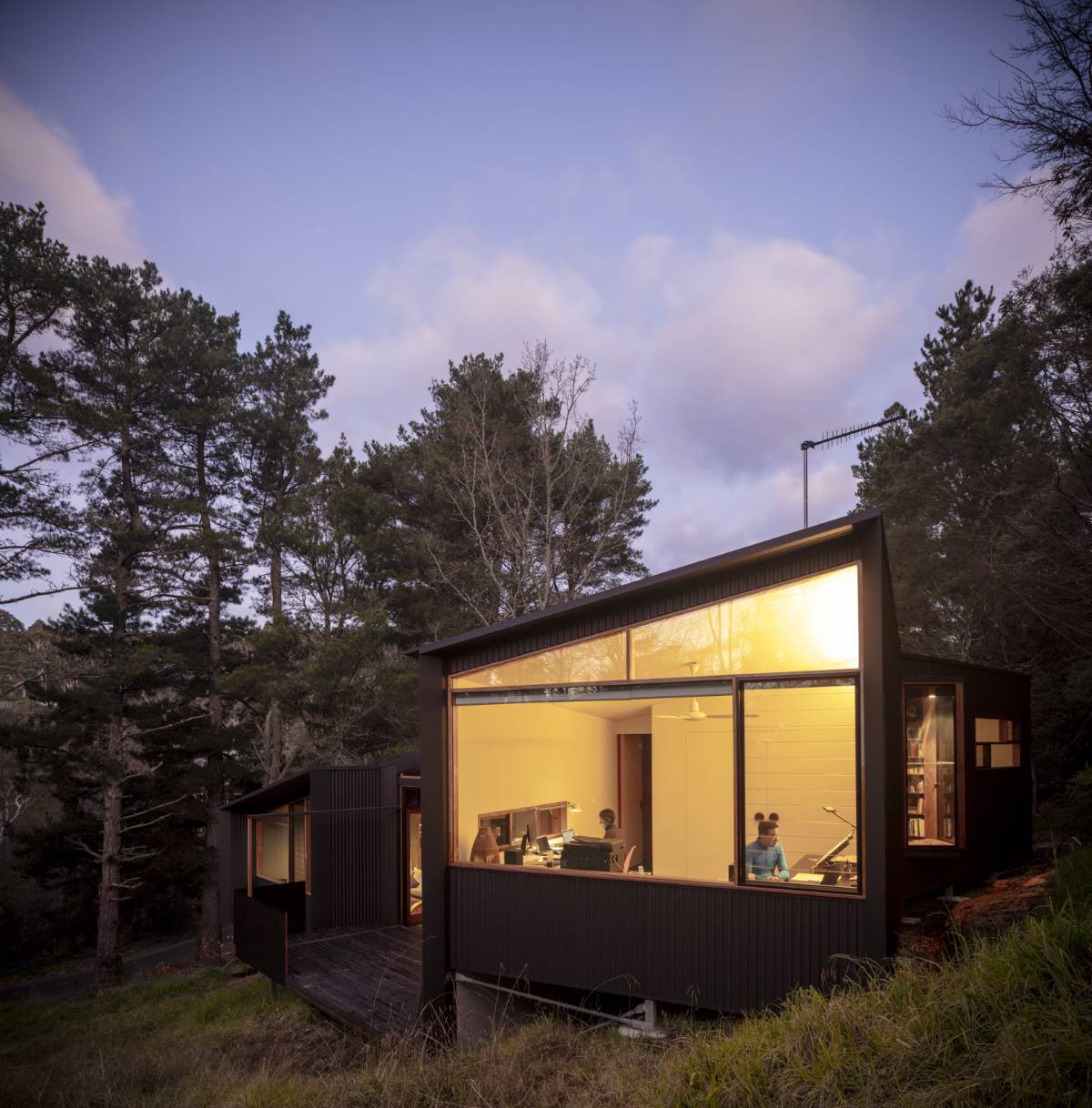
Harmonious exterior of the home office. Minimal impact upon and maximum gain from the environment. (Photo: Brett Boardman)
Take Action:
- Make your home more water and energy efficient.
- Protect and enhance the landscape around you.
- Integrate nature’s gifts into your home.
Share this article:
This story has been produced as part of a Bioregional Collaboration for Planetary Health and is supported by the Disaster Risk Reduction Fund (DRRF). The DRRF is jointly funded by the Australian and New South Wales governments.
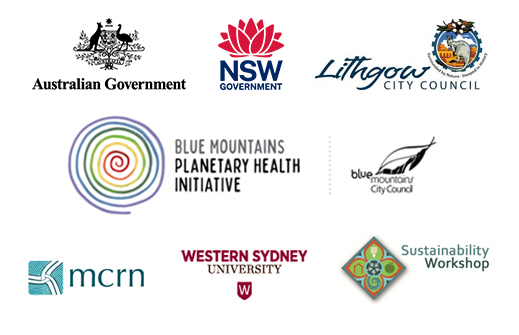
More from around the region
The fabulous Gang Gang Farmers Market in Lithgow will be back when the weather warms up. Meet some stallholders and whet your appetite for their Spring re-opening in Lithgow Area Local News (link in profile)
https://lithgowlocalnews.com/gang-gang-farmers-market/
#markets #lithgow #localproduce #planeteryhealth #buylocal
Imagine having enough absorbent green spaces, water tanks and underground water storage to capture the damaging stormwater that runs off hard surfaces in extreme wet weather events; imagine having enough stored water and the ability to clean all the water we use so that we are prepared for future drought and fire seasons. Join the discussion about how we can do this at a Free Water Symposium on Friday 26 July at the Planetary Health Centre. Bookings essential (link in profile): https://www.eventbrite.com.au/e/future-proofing-with-circular-water-tickets-943977701717
#circularwater #greywater #blackwater #stormwater #waterrecycling #togetherwecan #disasterriskreduction #beprepared #extremeweather #planetaryhealth #bushfire #flood #drought
Beyond the Yellow Bin: Surprising Things You Can Recycle – and How to Do it!
Here’s a guide to help Springwood and Greater Blue Mountains residents access the most effective recycling options available in the local area. Read more in Springwood Area Local News (link in profile): https://springwoodlocalnews.com/recycling-in-the-blue-mountains/
#recycling #circulareconomy #reuse #reduce #recycle #bluemountains #springwood #planetaryhealth #togetherwecan
Hamish Dunlop interviews prize-winning children’s book illustrator, mother, activist and proud Bundjalung woman, Charmaine Ledden-Lewis about the power of storytelling and how we can inspire our children to build a better world. Read more in Blackheath Area Local News (link in profile): https://blackheathnews.com/charmaine-ledden-lewis/
#changethestory #abetterworld #powerofstorytelling #bundjalung #illustrator #firstnations #planetaryhealth #blackheath #bluemountains
Broken chair? Blown amp? Busted washing machine? They don’t have to be thrown away! These Mid Mountains fixers and makers will revive them. Read more in our Mid Mountains Repair Guide: Choosing Longevity in an Age of Disposability. You can find it in Mid Mountains Local News (link in profile): https://www.midmtnslocalnews.com/mid-mountains-repair-guide/
#repair #repairculture #fixing #reuserecycle #longevity #togetherwecan #thebigfix #planetaryhealth #midmountains #repairguide
In this video, Dharug artist Leanne Tobin talks eloquently about the critical importance of water and why it`s the theme of her two paintings in the Water for Life exhibition at the Blue Mountains Planetary Health Centre. View the paintings and learn more about the many ways we can work together to manage water better at our free Water Symposium next Friday 26th July. Bookings essential (link in profile): https://bit.ly/3LiuJWi
The full video can be viewed on our YouTube channel (link in profile)
#waterforlife #leannetobin #firstnations #waterissacred #planetaryhealth #watersymposium
Electric vehicles continue to grow in popularity across Australia, but many people are still uncertain about their benefits, feasibility, and availability. To try and help local communities in the Lower Mountains have a better understanding of what EV’s can offer, @parentsforclimatebluemountains are hosting an EV Showcase in Blaxland on Saturday 27 July to help bust the EV myths and provide helpful, up-to-date and accessible information. 33 Hope Street Blaxland between 10 am and 12.30 Read more in Lower Mountains Local News (link in profile): https://lowermtnslocalnews.com/community-ev-showcase-blaxland/
#electriccars #blaxland #bluemountains #ev #planetaryhealth #towardszeroemissions
As part of our Water Demonstration Site at the Blue Mountains Planetary Health Centre we`ve installed a range of sprinklers to show people how to protect their homes from bushfire. Plumber Daniel Brown will be giving a tour at our upcoming event: Future Proofing with Circular Water on Friday 26 July. The event is free but bookings essential at https:bit.ly/4f78K1Z (link in profile) #bushfiresprinklers #beprepared #planetaryhealth
Global problems are creating renewed interest in traditional DIY skills like sewing. Here’s how a local grandmother is sharing her rag trade experience to make a difference and how you can get involved. Read more in Katoomba Area Local News (link in profile): https://www.katoombalocalnews.com/upcycling-fashion-workshops/
#skillshare #givingback #sharing #upcyclingfashion #sewing #patternmaking #repair #clothingadjustments #wastereduction #textilewaste #creativity #planetaryhealth
Calling all plumbers, builders, architects, engineers and any community members interested in learning ways we can manage water to reduce the impact of future droughts, floods and fires. On Friday 26 July we`ll be bringing together leaders in bushfire sprinkler system design, Hydraloop technology which can recycle 40% of your greywater, the program manager for drought from Sydney Water, and the designer of our 150,000l underground water storage system which will be capturing and cleaning stormwater for firefighting as a model for what we could build at the end of flame zone streets. Speak to a plumber about installing tanks and water systems and be in the running to trial one of two free Hydraloops we have on offer. This grant-funded event is free but bookings essential (link in profile):
https://bit.ly/4f78K1Z
This event is being supported by the Disaster Risk Reduction Fund which is funded by the Australian and New South Wales governments.
@hydraloop_systems @sydneywater @nswreconstructionauthority #greywaterrecycling #watertanks #firefighting #beprepared #drought #fire #flood #heatwave #bushfiresprinklers #planetaryhealth #disasterriskreduction
Our fortnightly Planetary Health Newsletter shares news about upcoming events, like our free Water Symposium on Friday 26 July, and stories from the Lower Mountains to Lithgow that are jam-packed with inspiration and a blueprint for the way forward.
Read it here and subscribe via any of our news sites (links in profile):
https://bit.ly/4cXQg2f
In this edition:
Katoomba Area Local News: Learning How To Upcycle Fashion with Sherlie McMillan
Mid Mountains Local News: Mid Mountains Repair Guide: Choosing Longevity in an Age of Disposability
Blackheath Area Local News: Charmaine Ledden-Lewis on Stories for a New World
Lower Mountains Local News: Busting The EV Myths: Community EV Showcase & Information Event Comes to Blaxland
Springwood Area Local News: Beyond the Yellow Bin: Surprising Things You Can Recycle – and How to Do it!
Lithgow Local News: The Gang Gang Farmers Market will Return in Spring!
#planetaryhealth #systemicchange #togetherwecan #solutions #constructivejournalism #watersymposium #hyperlocalnews
What an inspiring day at the Planetary Health Centre yesterday! We launched the Planetary Health Storytelling Network after a brilliant workshop with award-winning health writer and author Sophie Cousins on Our Community, Our Stories: Writing for Change. The Network will include all types of storytelling for planetary health: from songwriting to video, creative non fiction and visual arts. We`ll be having our first reading by Lorraine Shannon on the theme of GARDENS at 6.30pm on Thursday 8 August. All welcome to come along and share. SAVE THE DATE!
#planetaryhealth #changethestory #togetherwecan #storytelling #storytellingforchange #planetaryhealthstorytellingnetwork


